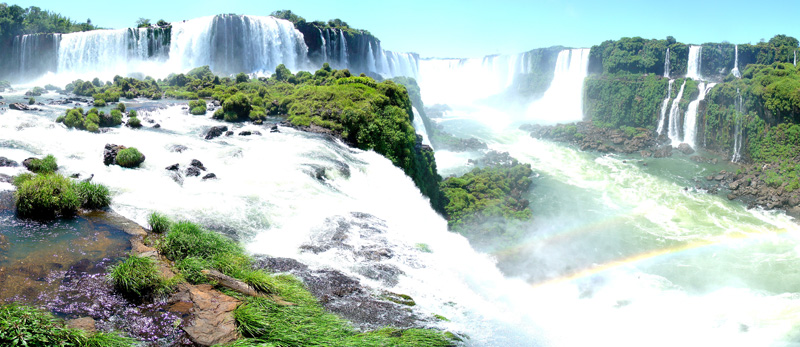Iguazu Falls, some quick facts

- Iguazu Falls, Iguassu Falls, or Iguaçu Falls (Portuguese: Cataratas do Iguaçu, Spanish: Cataratas del Iguazú), are waterfalls of the Iguazu River located on the border of the Brazilian state of Paraná and the Argentine province of Misiones. The falls divide the river into the upper and lower Iguazu.
- Their name comes from the Guarani or Tupi words y (water) and ûasú (big). Legend has it that a god planned to marry a beautiful aborigine named Naipí, who fled with her mortal lover Tarobá in a canoe. In rage, the god sliced the river creating the waterfalls, condemning the lovers to an eternal fall. The first European to find the falls was the Spanish Conquistador Álvar Núñez Cabeza de Vaca in 1541, after whom one of the falls in the Argentine side is named. The falls were rediscovered by Boselli at the end of the nineteenth century, and one of the Argentinian falls is named after him.
- The waterfall system consists of 275 falls along 2.7 kilometers of the Iguazu River. Some of the individual falls are up to 82 meters in height, though the majority are about 64 metres. The Garganta del Diablo (in Spanish; Devil's Throat in English; Garganta do Diabo in Portuguese), a U-shaped 150-metre-wide and 700-metre-long cliff, is the most impressive of all, and marks the border between Argentina and Brazil. Two thirds of the falls are within Argentine territory. About 900 metres of the 2.7-kilometer length does not have water flowing over it. The edge of the basalt cap recedes only 3 mm per year.
- The water of the lower Iguazu (after the falls) collects in a canyon that drains into the Rio Parana in Argentina, shortly downstream from the Itaipu dam.
- The falls can be reached from the two main towns on either side of the falls: Foz do Iguaçu in the Brazilian state of Paraná, and Puerto Iguazú in the Argentine province of Misiones as well as from Ciudad del Este (Paraguay) on the other side of the Parana river from Foz do Iguaçu. The falls are shared by the Iguazú National Park (Argentina) and Iguaçu National Park (Brazil). These parks were designated UNESCO World Heritage Sites in 1984 and 1986, respectively.
- On the Brazilian side there is a long walkway along the canyon with an extension to the lower base of the “Garganta del Diablo”. The Argentian access is facilitated by the Tren Ecológico de la Selva (Rainforest Ecological Train), which brings visitors to different walkways. The “Paseo Garganta del Diablo” is a one kilometer long way to bring the visitor directly over the falls of the “Garganta del Diablo”. Other walkways allow access to the elongated stretch of falls on the Argentinian side and to the ferry that connects to the San Martin island.
- Vastly larger than North America's Niagara Falls, Iguazu is rivaled only by Southern Africa's Victoria Falls which separates Zambia and Zimbabwe (this is excluding extremely large rapid-like falls such as the Boyoma Falls). Whilst Iguazu is wider because it is split into about 270 discrete falls and large islands, Victoria is the largest curtain of water in the world, at over a 1600 m wide and over 100 m in height (in low flow Victoria is split into five by islands; in high flow it can be uninterrupted). Iguazu, however, affords better views and walkways and its shape allows for spectacular vistas. At one point a person can stand and be surrounded by 260 degrees of waterfalls. The Garganta do Diabo has water pouring into it from three sides. Likewise, because Iguazu is split into many relatively small falls, one can view these a portion at a time. Victoria does not allow this, as it is essentially one waterfall that falls into a canyon and is too immense to appreciate at once (except from the air).
- Foz do Iguaçu is the 4th largest city of Paraná state, Brazil and the 11th largest of the Brazil's Southern region, with a population of 309,000 habitants . It is located approximately 650 km west of Curitiba, Parana's capital city. The inhabitants of the city are known as iguaçuenses. The city is one of the most visited by tourists in Brazil. Most tourists are Brazilians and Argentinians, but Americans, British, Germans, Italians, French, Portuguese, Spanish, Japanese and Chinese tourists are also numerous. The city has about 100 hotels and inns.
- The main attractions are: The Iguazu Falls, Parque Nacional do Iguaçu, Itaipu Dam, the largest generator of hydro-electric power in the world, The Tríplice Fronteira (Triple Frontier) location where Brazil, Argentina and Paraguay meet, The Omar Ibn Al-Khattab mosque, the largest outside Middle East, and The Bird Park (Parque das Aves), with a reasonably big collection of wild birds, and the "Bosque Guarani", the city's zoo.
- The Itaipu Dam produces about 20% of Brazil's electricity needs, and employs (directly and indirectly) about 5000 Iguaçuenses.
- In 1549, a Spanish explorer found the falls. Until 1860, it was in Paraguayan territory, but given its defeat in the War of the Triple Alliance, and big loses of territory to the winners, the falls passed to Brazilian control in the north side and Argentinian control in the south side. The region was almost uninhabited, there was only a military colony until 1897, with the creation of a postal office in the region. Given the little attention of the political authorities, the region was very predated by foreigners, mainly Argentinians. In 1910, the colony's status was upgraded to the position of "vila" (town or village), named "Vila Iguazu", and, in 1914, to city. From that time, the city was known as Foz do Iguaçu.

This and more information can be found on wikipedia: Igauzu Falls and Foz do Iguaçu. Other sites with good information are of course the sites of the Argentinian National Park and the Brazilian National Park.










